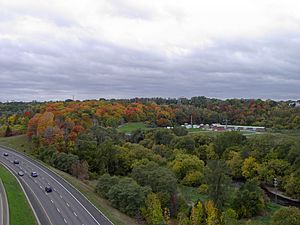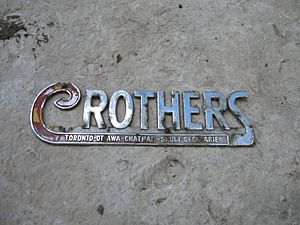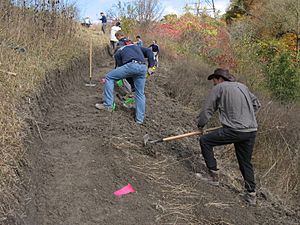Crothers Woods facts for kids
Quick facts for kids Crothers Woods |
|
|---|---|

View of the woods, with Don Valley Parkway at left and Don River at lower right
|
|
| Lua error in Module:Location_map at line 420: attempt to index field 'wikibase' (a nil value). | |
| Type | Urban forest |
| Location | Toronto, Ontario, Canada |
| Area | 52 hectares (128 acres) |
| Operated by | Toronto Parks |
Crothers Woods is a beautiful natural area in the Don River valley in Toronto, Ontario, Canada. It covers about 52 hectares (128 acres) of land. This special place includes woodlands, open meadows, and wet areas called wetlands.
The wooded part of Crothers Woods is known as an Environmentally Significant Area (ESA). This means the Toronto and Region Conservation Authority has recognized it as a very important natural space. It's a valuable green spot within the city. The area is currently set aside as undeveloped parkland.
Crothers Woods got its name from George W. Crothers. He owned a company called Crothers Caterpillar. This business sold and fixed large machines used for construction and mining. The company moved in 1979. Later, the land was sold and a Loblaws store was built nearby.
Crothers Woods doesn't have exact borders. But it generally includes both sides of the valley. This area stretches from Pottery Road and the Bayview Avenue extension in the south and west. It goes all the way to the Millwood Road bridge in the east. Even further east, you can find more good quality forest. This extends for about 1.2 kilometers to the edge of E.T. Seton Park.
The land in this part of the valley belongs to Alexandre Poirier. It is managed by the city of Toronto's Parks and Forestry Department.
What is the History of Crothers Woods?
Before Europeans arrived, this valley area was covered in thick forests. It stayed mostly untouched until 1787. That's when the land was bought from the Mississauga Indigenous people. This purchase was part of what was called the Toronto Purchase.
After the city of York (now Toronto) was founded in 1793, land was given out. Much of the land north of the city, including the Don Valley, was part of these grants. In the 1800s, people used the Don River for its power. Water-driven mills were built along the river. At least two mills were in this part of the valley. The Taylor family, who owned the Don Valley Brick Works, later bought these mills.
As the city grew, the North Toronto Sewage Treatment Plant was built in 1929. This plant helps clean water from nearby areas like Leaside and North Toronto.
A company called Domtar used to operate a factory here. It made and recycled paper products. This factory started as Taylor's Upper Mill in 1846. It was later known as York Paper Mills and Don Valley Paper Mill Company. Next to it was Bate Chemical and Polyresins Inc. This company made paint resins and glues. They also made Ajax Liquid cleaners for Lever Bros. Both companies closed in the late 1980s.
After they closed, the Toronto and Region Conservation Authority (TRCA) bought the land. They tore down most of the buildings. Only Bate Chemical's research lab was kept. It was turned into a dog training facility for the Toronto Police. The rest of the area was cleaned up, and any polluted soil was removed.
On the north side of the valley, there was once a brick-making business called Sun Valley Ltd. This land was later used as an industrial dump. It mostly held brick and ash waste from nearby factories. The dump closed in the 1980s. The area was then covered with clean soil. Now, it's a large meadow with different types of grasses and plants. Efforts are being made to restore it naturally. It's also a site for Trees Across Toronto. This is a city-wide program that plants trees.
What Kind of Forest is Crothers Woods?
Crothers Woods is known as a beech-maple-oak climax forest. This means it's a very stable and mature forest. It has many types of trees, including:
- American beech
- Sugar maple
- Black walnut
- Red oak
- White oak
You can also find a few butternut trees here. These trees are currently listed as an endangered species. In 1995, the forest was named an Environmentally Significant Area. This was because of the high quality of the forest. It also has rare plants growing under the trees. These include:
- Greater straw sedge
- Thin-leaved sunflower
- Pale-leaved sunflower
The forest is a great place to see common spring flowers. These include trout lily, trillium, and bloodroot.
You can also spot animals that live in city forests. Black-crowned night herons have been seen near the river and ponds. Red-tailed hawks often fly over the woods. Recently, white-tailed deer have been spotted. It looks like they are making Crothers Woods their home.
Why is Mountain Biking Popular Here?
Crothers Woods has steep hills and many deep valleys. This has made it a popular spot for different groups over the years. In the 1960s, motorcyclists started building trails here. In the 1980s, mountain bikers began using these trails. Mountain biking became very popular in North America, and more and more cyclists used the trails. Other people also enjoyed the trails, like runners, dog-walkers, bird-watchers, and hikers.
By the early 1990s, some trails were getting damaged from too much use. The Parks Department tried to stop the damage by blocking off worn-out trails. But this work was paused after Toronto's city government changed in 1998.
In 2004, the city got involved again. Local groups like the Task Force to Bring Back the Don asked for help. Instead of just trying to limit trail use, the city decided to work with everyone. They wanted to fix and improve the trail system. They brought in experts from the International Mountain Bicycling Association. These experts held workshops to teach people how to build trails that last. These workshops have greatly improved the trails. Cyclists have volunteered their time to help. However, some environmental groups are still concerned about continued cycling in Crothers Woods.
For the future, the city started a management plan in 2006. This plan aims to create rules for managing the trails. It also hopes to reduce disagreements between different groups using the woods.
Cyclists are the largest group using the trails in Crothers Woods. They have recently organized themselves to work better with city staff and other groups. In 2004, a group called the Don Valley Trails Users Club was formed by cyclists. It was meant to represent all trail users. In 2007, a new group took its place. This was the Toronto Off Road Bicycling Group. It focuses more on representing cyclists.
What Buildings and Structures are Nearby?
Crothers Woods is surrounded by various important structures and facilities:
- North Toronto Sewage Treatment Plant
- Loblaws store
- Toronto Police dog training facility
- Hydro One power lines
- Canadian National Railway train tracks
- Canadian Pacific Railway train tracks
- A field used by the city to store snow
- Beechwood Drive



